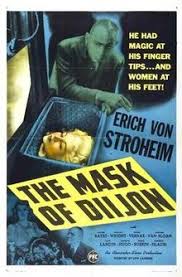
“You must never attempt to use this great gift with cruel sadistic or evil desire.”
Diijon (Erich von Stroheim) is a narcissistic rude vindictive ex-magician who thinks he can unlock the secrets of hypnosis and the power of the mind. He spends most of his time pouring over books on hypnosis and belittling his wife Victoria (Jeanne Bates). Without a job, no money is coming in.
Tony Holiday (William Wright) is an old friend, almost flame, from Victoria’s past. Tony shows up at the same boardinghouse where Diijon and Victoria live. Tony has a job at a nightclub. He offers to talk to the owner and see if he can get Diijon a job doing his magic act. At one time Diijon was considered one of the greatest magicians. Reluctantly Diijon agrees. The act doesn’t go well and Diijon is laughed off the stage. Diijon blames everyone except himself. Diijon storms off into the night.
Add to Diijon’s bruised ego the fact that he believes his wife is having an affair with the tall handsome Tony Holiday and you have one egomaniac ripe for retaliation. He doesn’t comprehend that he drove her away. His ego would not permit the idea that she didn’t love him anymore but it would allow an interloper’s attempt to take her away.
Later he is having coffee at a diner when a hood comes in and tries to hold up the place. Diijon hypnotizes the hood. He makes him turn over his gun, give back the money and leave. Realizing that he actually has the power to manipulate people using hypnosis Diijon tests his new power on one of the residents of the boardinghouse making him commit suicide. Knowing that he can make anyone do anything, he seeks revenge on the ones he believes are most against him. Oh, but things don’t go quite as planned.
“The Mask of Diijon” was released in 1946 and was directed by Lew Landers. This is a poverty row horror film from PRC. Sometimes the film has been labeled a film noir. “The Mask of Diijon” is moody and dark at times with some unusual camera angles and yes, a little fog walking along lonely streets at night. There are enough noir elements for it to qualify.
Stroheim’s performance in this piece is much better than in “The Crime of Dr. Crespi”. He is much more believable and much more sinister. He seemed more dynamic, more complicated. As for the other actors it didn’t really matter how well they performed since they were, at least to me, incidental to the movie. The plot and the film revolve around Stroheim and his dance with the devil.
There are some weak spots and some slow spots but the overall affect of the movie was good. Of course Stroheim carries most of the film. Even if you have problems with the pace of the film the last four or five minutes are where all the action takes place. And whether you like the ending or not, you will remember it.
Edward Van Sloan (from “Dracula” 1931) has a small part as Sheffield, a magic shop owner. There is one scene where he has a figurative and literal ball with the part. The scene serves no purpose other than to showcase Van Sloan’s flair with prestidigitation. It was, however, very enjoyable.

